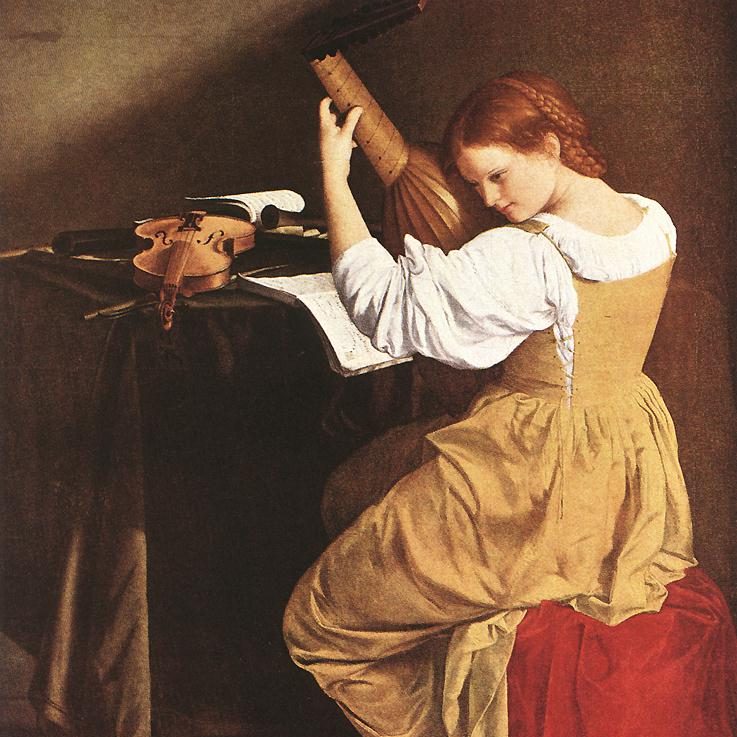Francesca Caccini (1587 – c. 1626)
Being born in Florence in 1587 meant being born into patriarchal society where most women are noted only in reference to their fathers. In this way, a young Francesca Caccini was largely known as “figliuola del celebratissimo Giulio Romano” or “the daughter of the celebrated Giulio Romano.”[1]

(1587 – c. 1626)
Francesca Caccini, or “Le Cecchina” as she was fondly called, was born into a family of successful artists. They were prominent enough to be employed by the Medici court however her childhood was not calm. Family scandals and gambling cost her father his position in the court for a period of time. Despite the family troubles, Francesca had a nice upbringing complete with a standard education for women during this time. This included learning how to sew and cook, among other household duties. Like many other women at this time, Francesca continued her education beyond managing a household. Studies of geography and art were often taught to keep women preoccupied so they would listen rather than speak.
Artistic studies such as music were often to realize the father’s ambitions. Francesca eventually mastered keyboards, viols, harp, lute, theorbo, and Spanish guitar. She excelled and continued her study with one of the finest singing teachers in Italy. She made her debut in 1600 as a teenager and quickly earned the attention of powerful members of the court.
One of her most supportive figures was Christine de Lorraine, the wife of Ferdinando I de’ Medici, Grand Duke of Tuscany. Having been sent to the country to look after familial relatives including a future queen of France and sister to a pope, Christine became the head of what would become known as the Women’s Court of Tuscany. Hidden away to preserve an image of modesty, the women of this court would issue commands which turned men to action. They would make art and music before entering the world to shape the flow of power throughout Europe.
It was through the patronage of the Grand Duchess and the support of her mother, Lucia di Filippo Gagnolanti, Francesca Caccini entered the women’s court “fiera ed irrequieta” – proud and restless.[2] Though she was moved about to serve, it was through the service of women that Francesca saw the potential to use her talents to influence power.
Her first marriage was to Giovanni Battista Signorini. It lasted from 1607 until his death in 1626 and saw the birth of her first child, a daughter they named Margherita. Francesca remarried only less than a year after Signorini’s death to nobleman Tommaso Raffaelli. This moment presents an interesting point in the available research on Caccini. Traditional sources tended to consider her second marriage to be her retirement from performance, however this perception has been questioned and proved untrue by more recent research.
As with many marriages during this time, they were often more about business than emotion. One line of research believes that Francesca’s marriages were well laid plans to secure her future and career. Her first marriage allowed her to continue working for the Medici court while her second saw her marry far above her station. These effectively represent the achievement of her father’s goal: upward social mobility for his family. This move did in no way mark the end of her career however. It in fact procured her musical services in the city of Lucca for the duration of her three year marriage.[3] After her husband’s death in 1630, she quickly tried to return to the Medici court only to be delayed by the plague. Caccini was back in the Medici court as soon as she was able and served as one of the finest music teachers in Italy.
Interested in Francesca Caccini’s own compositions? Unfortunately, many of her works have been lost, but it is believed that she wrote some or all of the material for at least sixteen staged works, in addition to educational books and hundreds of songs. Of her surviving works, Primo Libro della Musica is a collection of songs and duets which also serves as a teaching manual is one of the largest collections of songs published during that time. Her three act comedic opera, La Liberazione di Ruggiero, is thought to be the first large-scale staged work written by a female. It is also believed to be the first Italian opera to be performed outside of the country.
Christoforo Bronzini, a writer in Florence during the 16th century, compared Francesca Caccini to one legend of the muses. According to Bronzini’s tale, the muses were enslaved and put under the control of Megado, the daughter of the tyrannical King Macaro of Lesbos. The word for female servant at this time, according to Bronzino, was “musi.” After the muses brought harmony with their songs, the word “musi” came to refer to the women themselves and to the medium through which that knowledge emerged as power in the world: music.[1]
[1]Cusick, Suzanne G. Francesca Caccini at the Medici Court: Music and the Circulation of Power. The University of Chicago Press, 2015.
[2]Cusick, Suzanne G. “‘Thinking from Women’s Lives’: Francesca Caccini after 1627.” The Musical Quarterly, vol. 77, no. 3, 1993, pp. 484–507., doi:10.1093/mq/77.3.484.
[3]Cypess, Rebecca. “Francesca Caccini”. Encyclopedia Britannica, 14 Sep. 2020, https://www.britannica.com/biography/Francesca-Caccini. Accessed 12 April 2021.